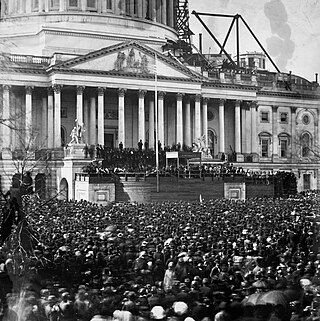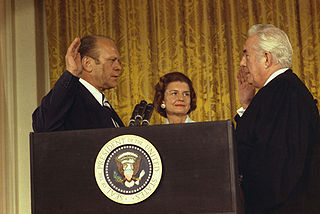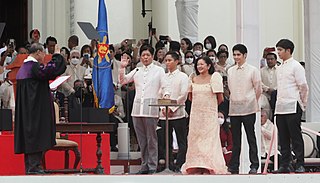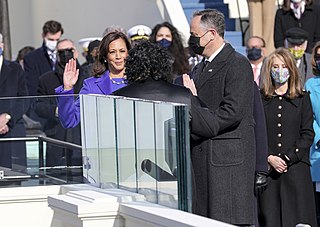
Article Two of the United States Constitution establishes the executive branch of the federal government, which carries out and enforces federal laws. Article Two vests the power of the executive branch in the office of the president of the United States, lays out the procedures for electing and removing the president, and establishes the president's powers and responsibilities.

Article Six of the United States Constitution establishes the laws and treaties of the United States made in accordance with it as the supreme law of the land, forbids a religious test as a requirement for holding a governmental position, and holds the United States under the Constitution responsible for debts incurred by the United States under the Articles of Confederation.

The vice president of the United States (VPOTUS) is the second-highest officer in the executive branch of the U.S. federal government, after the president of the United States, and ranks first in the presidential line of succession. The vice president is also an officer in the legislative branch, as the president of the Senate. In this capacity, the vice president is empowered to preside over the United States Senate, but may not vote except to cast a tie-breaking vote. The vice president is indirectly elected together with the president to a four-year term of office by the people of the United States through the Electoral College. Since the passage of the Twenty-fifth Amendment to the US Constitution, the vice president may also be appointed by the president to fill a vacancy, via majority confirmation by both the Senate and the House.

The oath of office of the president of the United States is the oath or affirmation that the president of the United States takes upon assuming office. The wording of the oath is specified in Article II, Section One, Clause 8, of the United States Constitution, and a new president must take it before exercising or carrying out any official powers or duties.

Between 73 and 79 days after the presidential election, the president-elect of the United States is inaugurated as president by taking the presidential oath of office. The inauguration takes place for each new presidential term, even if the president is continuing in office for a second term.

Abraham Lincoln's first inaugural address was delivered on Monday, March 4, 1861, as part of his taking of the oath of office for his first term as the sixteenth president of the United States. The speech, delivered at the United States Capitol, was primarily addressed to the people of the South and was intended to succinctly state Lincoln's intended policies and desires toward that section, where seven states had seceded from the Union and formed the Confederate States of America.

The inauguration of Gerald Ford as the 38th president of the United States was held on Friday, August 9, 1974, in the East Room of the White House in Washington, D.C., after President Richard Nixon resigned due to the Watergate scandal. The inauguration – the last non-scheduled, extraordinary inauguration to take place in the 20th century – marked the commencement of Gerald Ford's only term as president. Chief Justice Warren E. Burger administered the oath of office. The Bible upon which Ford recited the oath was held by his wife, Betty Ford, open to Proverbs 3:5–6. Ford was the ninth vice president to succeed to the presidency intra-term, and he remains the most recent to do so, as of 2024.

The first inauguration of George Washington as the first president of the United States was held on Thursday, April 30, 1789, on the balcony of Federal Hall in New York City, New York. The inauguration was held nearly two months after the beginning of the first four-year term of George Washington as president. Chancellor of New York Robert Livingston administered the presidential oath of office. With this inauguration, the executive branch of the United States government officially began operations under the new frame of government established by the 1787 Constitution. The inauguration of John Adams as vice president was on April 21, 1789, when he assumed his duties as presiding officer of the United States Senate; this also remains the only scheduled inauguration to take place on a day that was neither January nor March.

The first inauguration of Abraham Lincoln as the 16th president of the United States was held on Monday, March 4, 1861, at the East Portico of the United States Capitol in Washington, D.C. This was the 19th inauguration and marked the commencement of the first, and eventually only full term of Abraham Lincoln as president and the only term of Hannibal Hamlin as vice president. The presidential oath of office was administered to Lincoln by Chief Justice Roger B. Taney. John C. Breckinridge became the first outgoing vice president to administer the vice-presidential oath of office to his successor.

The first inauguration of Bill Clinton as the 42nd president of the United States was held on Wednesday, January 20, 1993, at the West Front of the United States Capitol in Washington, D.C. This was the 52nd inauguration and marked the commencement of the first term of Bill Clinton as president and Al Gore as vice president. At 46 years, 154 days of age at the time of his first inauguration, Clinton was the third-youngest person to become president, and the first from the Baby Boomer generation.

The first inauguration of George W. Bush as the 43rd president of the United States took place on Saturday, January 20, 2001, at the West Front of the United States Capitol in Washington, D.C. This was the 54th inauguration and marked the commencement of the first term of George W. Bush as president and Dick Cheney as vice president. Chief Justice William Rehnquist administered the presidential oath of office at 12:01 p.m., after he administered the vice presidential oath of office as well. An estimated 300,000 people attended the swearing-in ceremony. This was the first presidential inauguration to take place in the 21st century, and the first in the 3rd millennium.

The inauguration of George H. W. Bush as the 41st president of the United States was held on Friday, January 20, 1989, at the West Front of the United States Capitol in Washington, D.C. This was the 51st inauguration and marked the commencement of the only term of both George H. W. Bush as president and Dan Quayle as vice president. Chief Justice William Rehnquist administered the presidential oath of office to Bush and Justice Sandra Day O'Connor administered the vice presidential oath of office to Quayle. Bush was the first sitting vice president to be inaugurated as president since Martin Van Buren in 1837 and the last World War II combat veteran. Bush composed his own prayer for the ceremony which he recited at the start of his inaugural address; the last president to do so was Dwight D. Eisenhower at his first inauguration in 1953.

The first inauguration of Franklin D. Roosevelt as the 32nd president of the United States was held on Saturday, March 4, 1933, at the East Portico of the United States Capitol in Washington, D.C. This was the 37th inauguration, and marked the commencement of the first term of Franklin D. Roosevelt as president and John Nance Garner as vice president.

The second inauguration of Abraham Lincoln as president of the United States took place on Friday, March 4, 1865, at the East Portico of the United States Capitol in Washington, D.C. This was the 20th inauguration and marked the commencement of the second and final term of Abraham Lincoln as president and only term of Andrew Johnson as vice president. Lincoln was assassinated 42 days into this term, and Johnson succeeded to the presidency. Chief Justice Salmon P. Chase administered the presidential oath of office. This was the first inauguration to feature African Americans in the inaugural parade, and the first president in over 30 years to be inaugurated for a second term since the second inauguration of Andrew Jackson in 1833.

The second inauguration of Andrew Jackson as president of the United States took place in the House Chamber of the U.S. Capitol on Monday, March 4, 1833. The inauguration marked the commencement of the second four-year term of Andrew Jackson as president and the only four-year term of Martin Van Buren as vice president.

The inauguration of John F. Kennedy as the 35th president of the United States was held on Friday, January 20, 1961, at the East Portico of the United States Capitol in Washington, D.C. This was the 44th inauguration and marked the commencement of John F. Kennedy's and Lyndon B. Johnson's only term as president and vice president. Kennedy was assassinated 2 years, 306 days into this term, and Johnson succeeded to the presidency.

The first inauguration of Ulysses S. Grant as the 18th president of the United States was held on March 4, 1869, at the East Portico of the United States Capitol in Washington, D.C. This was the 21st presidential inauguration and marked the commencement of the first four-year term of Ulysses S. Grant as president and the only term of Schuyler Colfax as vice president. Chief Justice Salmon P. Chase administered the presidential oath of office. Outgoing president Andrew Johnson did not attend the inaugural ceremonies, as he and Grant refused to sit with each other in the carriage going to them. Johnson also refused to go in a separate carriage. Instead, he was in the White House signing last-minute legislation. This was the fourth time an outgoing president boycotted his elected successor's inauguration, an event that would not occur again until Donald Trump boycotted Joe Biden's inauguration in 2021 after failing to overturn the results.

The second inauguration of Calvin Coolidge as president of the United States, was held on Wednesday, March 4, 1925, at the East Portico of the United States Capitol in Washington, D.C. This was the 35th presidential inauguration and marked the commencement of the second and only full term of Calvin Coolidge as president and the only term of Charles G. Dawes as vice president. Chief Justice William Howard Taft, who had served as president from 1909 to 1913, administered the oath of office. This was the first inauguration on which a former U.S. president administered the Oath and the first to be broadcast nationally on radio.

The inauguration of the president of the Republic of the Philippines is a ceremony marking the commencement of the six-year term of a president of the Philippines, who is both head of state and head of government. The inauguration is performed on June 30, as mandated by the 1987 Constitution. Under the older 1935 Constitution, the date was December 30, which is also Rizal Day; the last inauguration held on the older date was Ferdinand Marcos' second one on December 30, 1969. The most recent public presidential inauguration ceremony was that of President Bongbong Marcos, who began his six-year term in office on Thursday, June 30, 2022.

The oath of office of the vice president of the United States is the oath or affirmation that the vice president of the United States takes upon assuming the vice-presidency but before beginning the execution of the office. It is the same oath that members of the United States Congress and members of the president's cabinet take upon entering office.




















